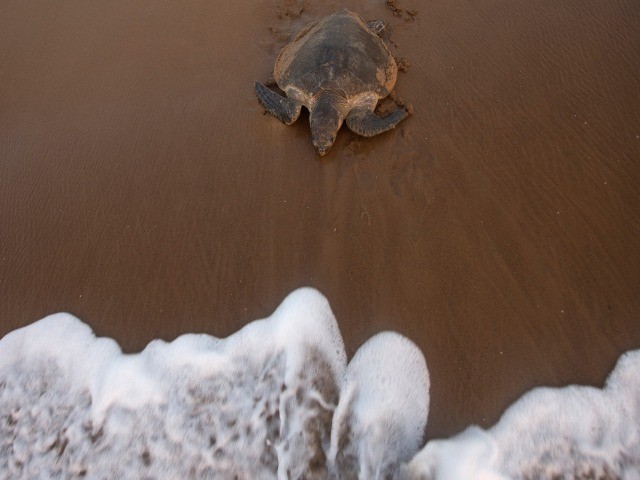National
Award-winning Hornbill Nest Adoption Program (HNAP) in Arunachal Pradesh turns 10
Operating in the forests outside the Pakke Tiger Reserve in Arunachal Pradesh, the community-based conservation programme for hornbills is celebrating its tenth year of success. The Hornbill Nest Adoption Program (HNAP) was officially launched in 2012 by the Nature Conservation Foundation (NCF) in partnership with the Ghora-Aabhe Society (a council of village headmen in the Nyishi tribe) and the Arunachal Pradesh Forest Department. The programme provides a source of livelihood for 21 nest protectors, who have overseen the successful fledging of 173 hornbill chicks of three hornbill species—Great Hornbill, Wreathed Hornbill and Oriental Pied Hornbill—and protection of 35 hornbill nests in the reserve forest in 10 years. Over 260 hornbill parents and 15 international zoos have supported and helped sustain the programme. Learn more about hornbill species of India, here.
Olive Ridley Sea Turtles arrive en masse to nest on Odisha’s beaches
Lakhs of Olive Ridley Turtles are swarming the beaches of Odisha for the annual mass nesting, forest officials reported on Monday. There were apprehensions that the turtles might skip their annual visit as the mass nesting was delayed by around a fortnight. The turtles started arriving at the Gahirmatha beach, the world’s largest-known nesting ground for Olive Ridley Turtles, on Friday, March 25. Around 2.45 lakh female turtles crawled to the seashore, which is probably the largest congregation at the nesting beach on a single day, according to J D Pati, the Divisional Forest Officer of Rajnagar Mangrove (Wildlife). Sunday morning saw them arrive at the Rushikulya river mouth in the Ganjam district, where 40,533 female turtles laid eggs on an island formed near the river mouth.
Read more: Olive Ridley turtles flock Odisha seashores, mass nesting on | ThePrint
Around 100 vultures fall prey to poisoning in Assam
Locals of Milanpur village in the Kamrup district of Assam found 95 dead bodies of Himalayan Griffon Vultures on March 17, 2022. The locals informed the forest officials, and along with scientists from BNHS, they were able to save ten vultures and a Steppe Eagle, currently undergoing treatment at the BNHS centre. The post-mortem report found the cause of death as pesticide poisoning due to carbofuran. “This was a case of unintentional poisoning of vultures when they ate the two poisoned carcasses. Sometimes, feral dogs chase cattle and injure them, because of which farmers have to incur losses. They spray the carcasses of cattle with pesticide to kill the dogs," said Sachin Ranade of the Vulture Breeding Centre at Rani in the Kamrup district. The vulture carcasses were cremated to prevent the poison from entering the food chain.
More national headlines:
- Permanent Body constituted to prevent elephant deaths on railway tracks | The Hindu
- Hyderabad, Bengaluru saw an increase in pollution in 2021: Air quality report | The News Minute
- Researchers detect new species of jumping spider in Rajasthan’s Thar Desert | Mumbai News | Hindustan Times
- Study reveals significant decline in Golden Langur habitat | The Hindu
International
New captive birth rekindles hope for the critically endangered Sumatran Rhino
Indonesia reported the birth of a Sumatran Rhinoceros in a captive-breeding programme for the critically endangered species. According to a statement from the Indonesian environment ministry, the Sumatran rhino was born on March 24 at the Sumatran Rhino Sanctuary in Sumatra’s Lampung province. The female calf is the offspring of Andatu, a male born at the sanctuary in 2012, and Rosa, a female captured from the wild in 2005. Indonesia is the last refuge for the endangered Sumatran Rhino. Before this new birth, Rosa miscarried eight pregnancies between 2017 and 2020. The wild population of the Sumatran Rhinoceros is estimated to be no more than 80 individuals.
Read more: It's a girl: Super rare Sumatran rhino born in captive-breeding centre | Mongabay
Massive Antarctica ice shelf collapses after extreme heatwave
Following a period of extreme heat in the region, the 1,200sq.km. Comber Ice Shelf, a thinning East Antarctica ice shelf, completely collapsed on or around March 15. The March heatwave, owing to the atmospheric river phenomenon (the process creates columns hundreds of kilometres long that carry water vapour from the tropics), saw temperatures reach 40°C above normal in parts of East Antarctica. Temperatures that sit at about -51°C at this time of year hovered around -12°C this March. The Conger shelf was splintering long before the heatwave. But its demise shows that even the frozen continent, which is surrounded by vast oceans and buffered by winds that protect it from large warm-air intrusions, is sensitive to atmospheric changes.
Read more: Thinning Antarctica ice shelf collapses after heatwave | Climate Crisis News | Al Jazeera









